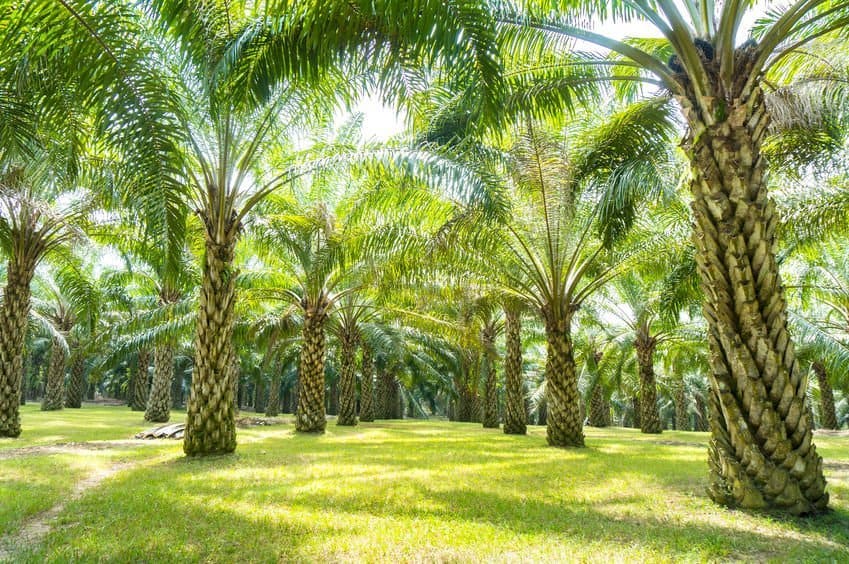Palm Oil: The Ugly Truth
The truth is that most people have no clue what goes into the products that they use daily. The ugly truth is that if they knew, they would probably never want to use them again. In the beauty and skincare industry, one such pariah is Palm Oil. The devastation caused by this one ingredient to people, wildlife, and the planet, is so complicated and far-reaching that it deserves our immediate attention.
What is Palm Oil?
Palm Oil is a type of vegetable oil that is derived from oil palms. Oil palms are an ancient staple crop in West Africa and the tree bears giant bunches of red fruit beneath its fronds. For millennia, humans have harvested the fruit, boiled, and pounded it to extract cooking oil, burned the kernel shells for heat, and used woven palm fronds to make rooves and baskets.
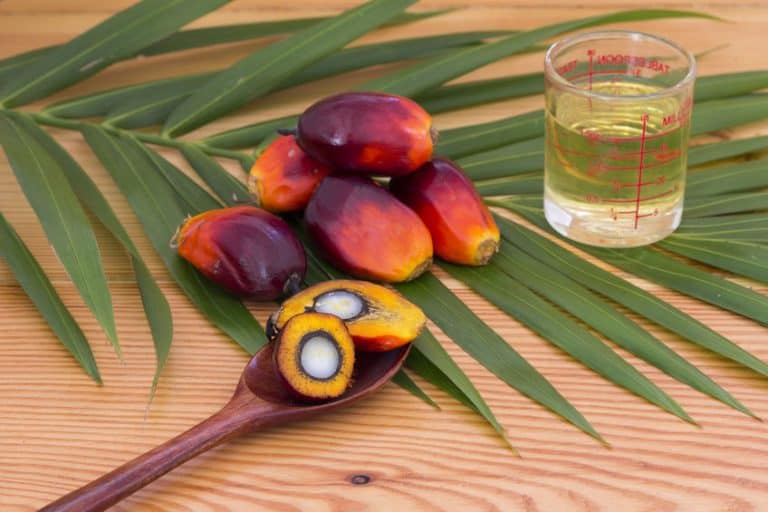
Palm Oil fruit (Elaeis guineensis).
Why is Palm Oil so Popular?
Owing to its versatility and the efficiency with which it can be produced (requiring only half as much land as other crops, such as soybeans, to generate a given amount of oil), the use of Palm Oil within the past few decades has skyrocketed. In fact, palm oil is the most efficient oilseed crop in the world. A hectare of palm oil plantation can produce almost ten times the amount of oil than the next closest type of oilseed such as rapeseed.
Palm Oil has been successfully transplanted to other tropical regions and it is now mainly supplied by Indonesia and Malaysia. It is now the most popular vegetable oil in the world, accounting for one-third of global consumption, and it is almost unavoidable, being found in many consumer and industrial products, such as food and beverages, personal care and beauty products, bioenergy and fuel, animal feed, pharmaceuticals, industrial activities, and the food service industry. Biscuits, spreads, chocolate, bread, personal care products, detergents, soap, lipstick… these are just a few of the multitude of items containing Palm Oil that you are more than likely to have in your home right now.
Palm oil is used extensively in the cosmetic and food industries and the global demand for it continues to rise with consumption exceeding 70 million metric tonnes annually.
With its use in so many everyday applications, it begs the question, how can this ‘tree of plenty’ be so bad? What is the real issue with palm oil?
The Dark Side of Palm Oil
The real issue with Palm Oil is its unsustainable production rather than the product itself. There is little regulation in the destruction of rainforest areas, and it is currently very difficult to trace whether the palm oil in products was really produced sustainably.
Unsustainable palm oil has a devastating effect on the environment. Palm oil has been, and continues to be, a major driver of deforestation of some of the world’s most biodiverse forests, causing mass destruction to the habitats of already endangered species, and contributing to climate change by releasing millions of tonnes of greenhouse gases into the atmosphere. The aggressive burning and clearing of forests in Indonesia alone contribute to 12% of all global carbon emissions.
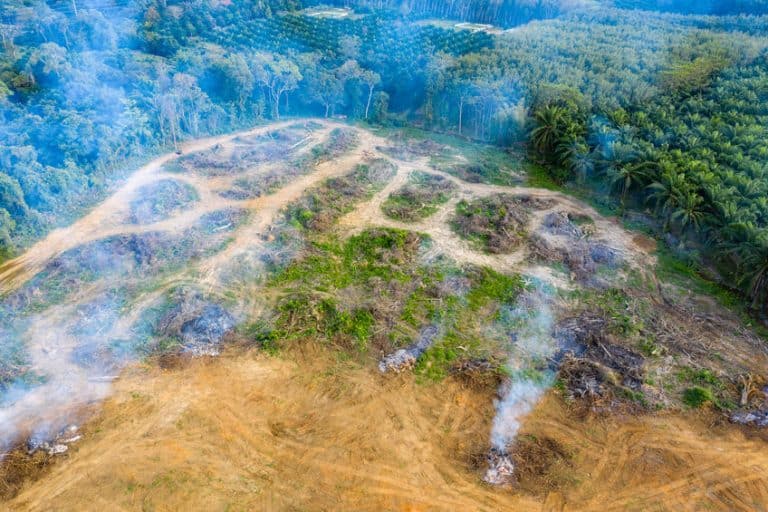
Aerial drone view of rainforest being burnt and cleared to make way for palm plantations in Indonesia.
The haze from Indonesian forest fires, many deliberately set to clear land for oil palms, caused at least 12,000 premature deaths in 2015 alone.
According to Greenpeace, land equivalent to the size of a football field is lost every 25 seconds in Indonesia alone. The World Wildlife Fund (WWF) estimates that worldwide, around 300 football fields of forest are cleared every hour to make way for palm oil plantations.
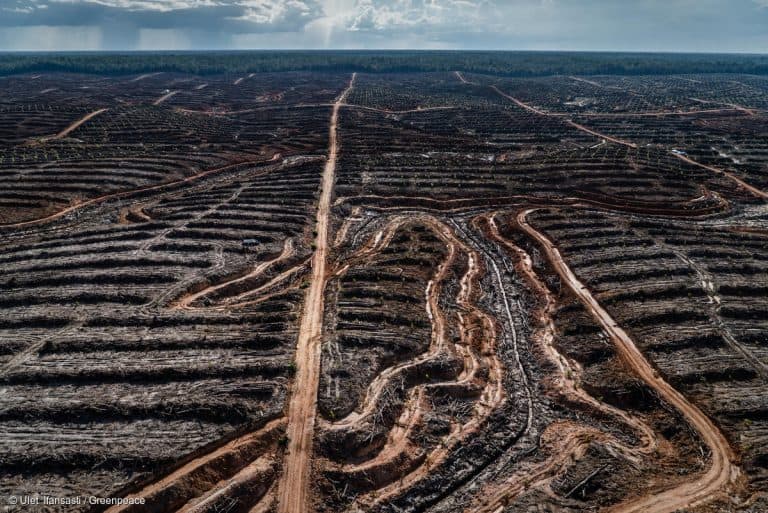
Landcover, forest clearance and plantation development in PT Megakarya Jaya Raya (PT MJR) palm oil concession. Source: Greenpeace.
In Borneo, the island shared by Malaysia and Indonesia, since 1973, almost 42,000 square kilometers of rain forest has been burned and bulldozed to create space for oil palms. Since 2000, oil palms have accounted for 47% of the world’s total deforestation. All this deforestation has wreaked havoc on local wildlife. Nearly 150,000 endangered Bornean orangutans have perished from 1999-2015. According to a report from the World Wildlife Fund, elephants, Sumatran tigers, and rhinos are also on the brink of extinction.

Orangutans in Borneo where rainforest has been cleared for palm oil plantations. ULET IFANSASTI/GETTY IMAGES
Human rights abuses in and around these plantations run rampant. On the Indonesian island of Sumatra, palm oil companies have bulldozed entire villages of indigenous peoples, leaving their residents homeless and reliant on government aid.
In 2020, the Associated Press conducted a comprehensive investigation that focused on the brutal treatment of women employed on these plantations. The report highlighted the hidden scourge of sexual abuse (with many reporting repeatedly being raped by their employers), threats and verbal harassment along with human trafficking, child labour (as young as 5 years old), and what can only be considered as modern-day slavery. Women are burdened with some of the most dangerous jobs in the industry, forced to spend hours carrying such heavy loads that can cause their wombs to collapse. Chemically contaminated water can add to the burden by causing terrible sickness. Most workers are hired as subcontractors, without any benefits, and sometimes making only $2 per day.

Female worker carrying a heavy load at a palm oil plantation in Sumatra, Indonesia. (AP Photo/Binsar Bakkara).
It seems painfully ironic that palm oil, harvested in such ugly and inhumane ways, is used in products to make one ‘beautiful’.
Palm Oil and the Beauty Industry
The derivatives of palm oil (glycerol, fatty acids, or fatty alcohols) are used in many products because of their emollient or foaming properties.
The two main types of oil from the oil palm are palm oil and palm kernel oil. To make palm oil, the fruit is pressed to extract crude palm oil [CPO] which is refined to become edible. The CPO is then processed to become refined, bleached, and deodorized (RBD) palm oil. Alternatively, the oil can be extracted straight from the kernel as palm kernel oil. Palm kernel oil is what is used in the manufacture of foods and cosmetics because it can maintain its structure under high temperatures, it is creamy and smooth in texture, and it is odourless.
Although the beauty industry reportedly only accounts for 2% of global palm oil production, it can be found in as many as 70% of all beauty products. The fact that it is cheap and versatile makes it an attractive addition. In lipsticks, the addition of palm oil allows them to remain tasteless, prevents them from melting, and allows their colours to last much longer.
The problem with palm oil is ultimately one of production greed. Efficiency and low-cost equals good profit for companies that use palm oil in their products. This relentless drive for short term profit and growth always comes at the expense of something or someone. Sadly, this case is no different.
What has been done so far to manage sustainable Palm Oil?
In response to the urgent and pressing global call for sustainably produced palm oil, the Roundtable on Sustainable Palm Oil (RSPO) was formed in 2004 with the objective of promoting the growth and use of sustainable oil palm products through credible global standards and engagement of stakeholders. RSPO-certified palm growers are audited by an independent, accredited certification body that supposedly ensures that strict social and environmental guidelines are followed during production.
Although this represents progress, unfortunately the certifications are far from perfect and there are many loopholes. According to two separate reports from campaigning groups WWF and Rainforest Action Network, some of the world’s biggest brands are failing in their commitments to banish deforestation from their supply chains through their use of palm oil, despite making public claims to environmental sustainability.

Landcover, forest clearance and plantation development in PT Megakarya Jaya Raya (PT MJR) palm oil concession. Source: Greenpeace.
Is Palm Oil sustainable at present?
In the short term, NO. In the long term – truly sustainable palm oil, YES.
In September 2018, a comprehensive investigation by Greenpeace exposed how the world’s biggest brands are still linked to rainforest destruction in Indonesia. Palm oil suppliers to the world’s largest brands, including Unilever, Nestlé, Colgate-Palmolive and Mondelez, have destroyed an area of rainforest almost twice the size of Singapore in less than three years, according to the report.
The report highlighted how some of the largest members of the RSPO, who supposedly produce and sell ‘sustainable’ palm oil, routinely flout the laws and rules which they are supposed to abide by. The outcome of the report was that large companies who claim to only use sustainable palm oil in their products are in fact selling the public a lie and that production of sustainable palm oil under the RSPO is fiction.
There is now a realisation that RSPO-certification is currently “inadequate” as a guarantee that the palm oil in use is not leading to deforestation. In other words, just because a company or product is RSPO-certified there is NO guarantee that the palm oil they have used has not caused deforestation.
As a result of these collective failures, brands and traders who still source palm oil from non-sustainable producer groups are not just complicit in rainforest destruction and exploitation, but – through their palm oil purchases – actively funding those responsible for it. These factors represent the greatest known threats to Indonesia’s rainforests and local communities.
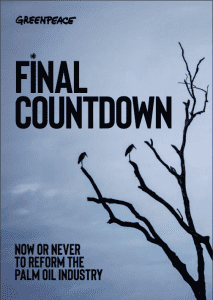
Read the Palm Oil Investigation by Greenpeace here
What can you do to support the sustainable production of palm oil?
It has been proven that palm oil production is NOT sustainable at present, and that deforestation, and devastation to human life, wildlife, and the environment continues because of it.
Palm oil’s reach is not going away anytime soon. It is found in just about everything — from cookies, chips, and bread, to wide a range of personal care products. Palm oil is part of our lives, but rainforest destruction and the cascading human health effects from the burning and clearing of forests shouldn’t be. Nor should the welfare of workers and neighboring communities who are violated at the cost of producing this vegetable oil.
In our opinion, and many others, the best option to support the sustainable production of palm oil is to AVOID purchasing beauty products (or any products) containing non-RSPO certified palm oil.
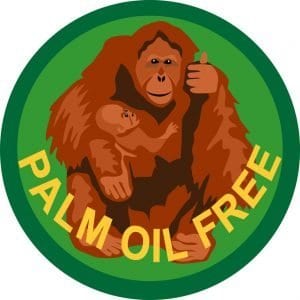
The best way to do this is by reading and understanding ingredient labels! DO NOT buy products with palm oil, palm kernel oil, or palm oil derivatives in the ingredient list unless the company states their palm oil ingredients are RSPO certified. It is important to note that when reading labels, ‘Palm Oil’ may not be listed, but one of its 200+ derivatives may be. Orangutan Alliance have compiled a list of alternative names for palm oil which you can read at the end of this article. Familiarizing yourself with some of them may seem a big task but a helpful tip is to avoid ingredients with the root word being ‘palm’ or that have ‘palm’ in it (for e.g., palmitic acid, hydrated palm glycerides, palm kernel, palm kernel oil, palm fruit oil, palmate, palmitic acid, palm stearine, palmitoyle, etc) or other common ‘palm’ derivatives with the words ‘stear’ and ‘laur’ (for e.g., stearate, stearic acid, and sodium lauryl sulfate). In New Zealand it is not a requirement to label a specific oil, ‘vegetable oil’ is acceptable. If an ingredient label states ‘vegetable oil’ then it is more than likely palm oil.
By avoiding products made with palm oil, and supporting companies who choose not to use palm oil, or palm oil derivatives, unless they are RSPO certified, we are being ‘conscious consumers‘. Conscious consumerism is a vital part of sustainability. It is the awareness of how every purchase that we make has an impact on the environment. By being a ‘conscious consumer’, we can all contribute to a more sustainable world that respects basic human rights, protects the environment and the planet so it will be here for future generations to enjoy. We are also sending a strong message that we won’t accept unsustainable and unethical products, giving the rain forests a bit of respite and a chance to survive.
Palm oil sustainability is a very complex issue with many consequences, but we can make a difference by choosing to buy palm oil free products wherever possible. The more we talk about this issue, share information with each other, and make a collective stand against it, the sooner truly sustainable palm oil will be available without the catastrophic effects linked to it now.

Final Thoughts…
The devastation to human life, wildlife, and the environment is simply too high a price to pay when it comes to buying beauty and skincare products that contain palm oil. We should all do what we can to support basic human rights, protect critically endangered species, and preserve our planet. There are companies out there trying to play their part by avoiding the use of non-RSPO certified palm oil in their products and we should do our bit by supporting them.
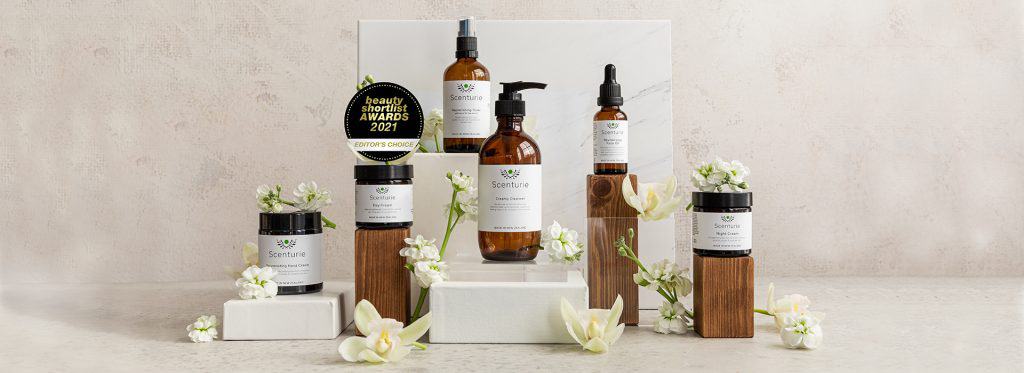
Scenturie is a natural skincare brand based in New Zealand that lives by the ethos “Respect for our planet, its resources, and each other. Our products are cruelty-free, 100% vegan, ethically sourced, and free from harmful chemicals. We have chosen to avoid using palm oil and palm oil derivatives in our formulations, wherever possible. We use ‘Brassica alcohols’ as one of our chosen emulsifiers, which are naturally derived from waxes found in plants from the Cabbage (Brassica) family. They are a palm oil-free natural alternative for fatty alcohols used in skincare products. The other natural emulsifiers we use are cetearyl olivate and sorbitan olivate. These ingredients are developed from natural olive derivatives, however, the manufacturing process involves combining them with the ingredient cetearyl alcohol which is a RSPO-certified palm oil derivative. We are always on the lookout for an effective 100% palm oil-free emulsifier but to date we have not found one. This is the closest we can currently get to achieving palm oil-free status. We use NO parabens, sulfates, phthalates, glycols, silicones, phenoxyethanol, or mineral oils in our products. Our packaging is all recyclable, reusable, and compostable, and as part of our committment to ongoing sustainability we offer a returnable product packaging service.
Alternative Names for Palm Oil Derivatives
Below are some examples of how palm oil may be referred to on packaging. This doesn’t mean that all these ingredients are definitely palm oil, (for instance E471 may be palm oil, coconut oil, soybean oil, cottonseed oil or canola oil), but they could be. This list is from The Orangutan Alliance.
Acetic and fatty acid esters of glycerol (472a/E472a)
Acetylated Monoglycerides
Alkylamidopropyl betaine
Alkyl alcohol
Alkyl betaine
Alkyl ether sulfate
Alkyl Polyglucoside
Aluminum Myristates/Palmitates
Aluminium stearate
Aluminium, calcium, sodium, magnesium salts of fatty acids (470/E470a; E470b)
Amidopropyl betaine
Ammonium laureth sulphate
Ammonium lauryl sulphate
Amphoteric surfactant
Anionic surfactant
APG
Arachamide mea
Ascorbyl palmitate (304)
Ascorbyl stearate
Ascorbyl Tetraisopalmitate (vitamin C)
Azelaic acid
Beta Carotene
Behentrimonium Methosulfate
BTMS
Butyl Myristate
Butyl stearate
Calcium lactylate
Calcium Myristate
Calcium oleyl lactylate
Calcium stearate
Calcium stearoyl lactylate
CAPB
Capric triglyceride
Caprylic acid
Caprylic / Capric Glycerides
Caprylic triglyceride
Caprylic/capric triglyceride
Caprylic/capric/stearic triglyceride
Capryloyl glycine
Caprylyl glycol
Carboxylic acid soap
Carotene (Sometimes made from palm)
Castile soap (often from palm)
Castor Isostearate Beeswax Succinate
Ceteareth (2-100)
Ceteareth mbsfl laurethulanate
Ceteareth mbhe laurethulanate
Cetearyl alcohol
Cetearyl ethylhexanote
Cetearyl glucoside
Cetearyl isononanoate
Cetearyl and Sorbitan Olivate
Ceteth-20
Ceteth-24
Cetostearyl Alcohol
Cetrimonium Bromide
Cetremonium Chloride
Cetyl acetate
Cetyl alcohol
Cetyl chloride
Cetyl ethylhexanoate
Cetyl hydroxyethylcellulose
Cetyl lactate
Cetyl Myristate
Cetyl octanoate
Cetyl palmitate
Cetylpyridinium chloride
Cetyl ricinoleate
Cetyltrimethylammonium bromide
Cetyltrimethylammonium chloride
Citric and fatty acid esters of glycerol
Cocoa butter equivalent (CBE)
Cocoa butter substitute (CBS)
Cocamide DEA
Cocamide MEA
Cocamidopropyl betaine
Coco-Caprylate
Coco-Caprylate/Caprate
Coco Polyglucose
Cocoyl Sarcosine
Conditioning emulsifier
Decyl Glucoside
Decyl Myristate
Decyl oleate
Diacetyltartaric acid esters of monoglycerides
Diacetyltartaric and fatty acid esters of glycerol
Dicaprylyl ether
Dicocoylethyl Hydroxyethylmonium Methosulfate
Dihydroxystearic acid
Diisostearyl Malate
Dilinoleic acid
Dipalmitoylethyl hydroxyethylmonium methosulfate
Di-ppg-2 myreth-10 adipate?
Disodium laureth sulfosuccinate
Disodium lauryl sulfosuccinate
Distilled Monoglyceride Palm
Dodecanol
Elaeis guineensis
Emulsifiers: E304, E422, E430, E431, E432, E433, E434, E435, E436, E470, E470a, E470b, E471, E472, E472a, E472b, E472c, E472e, E472f, E473, E474, E475, E476, E477, E478, E479, E480, E481, E482, E483, E493, E494, E495
Emulsifying wax
Epoxidized palm oil (uv cured coatings)
Esterquats
Esters of Myristic Acid
Ethoxylated Lauryl Alcohol
Ethoxylated Monoglycerides
Ethoxylated SMS
Ethoxylated SMO
Ethoxylated STS
Ethyl lauroyl arginate (243)
Ethyl myristate
Ethyl palmitate
Ethylene glycol diesters
Ethylene glycol monoesters
Ethylene glycol monostearate
Ethyl hexyl Esters-2
Ethylhexylglycerin
Ethylhexyl hydroxystearate
Ethylhexyl Isononanoate
Ethylhexyl Myristate
Ethylhexyl Palminate
Ethylhexyl palmitate
Ethylhexyl stearate
Ethylhexylglycerin
Etyl Palmitate
Fatty acids
Fatty acid methyl esters (FAME)
Fatty alcohol alkoxylate
Fatty alcohol sulphates
Fatty amines
Fatty isethionate
FP(K)O – Fractionated Palm Oil
Fractionated Palm Oil
Glycerin
Glycerin or glycerol (442)
Glycerol esters
Glyceryl cocoate
Glyceryl dioleate
Glyceryl Dimyristate
Glyceryl distearate
Glyceryl laurate
Glyceryl Linoleate
Glyceryl monostearate
Glyceryl myristate
Glyceryl oleate
Glyceryl polymethacrylate
Glyceryl Rosinate
Glyceryl stearate
Glyceryl stearate SE
Glycol distearate
Glycol stearate
Guineesis (palm)
Hexadecanoic acid
Hexadecylic
Hexyl laurate
Hexyldecanol
Humectant 422
Humectant glycerol
Hydrated palm glycerides
Hydrogenated palm glycerides
Hydroxy Stearic Linolenic
Isoamyl Laurate
Isobutyl Myristate
Isocetyl alcohol
Isocetyl Myristate
Isocetyl stearate
Isodecyl Myristate
Isodecyl oleate
Isononyl Isononanoate
Isopropyl esters
Isopropyl isostearate
Isopropyl Myristate
Isopropyl palmitate
Isopropyl titanium triisostearate
Isostearamide DEA
Isostearate DEA
Isostearic acid
Isostearyl alcohol
Isostearyl Hydroxystearate
Isostearyl isostearate
Isostearyl Myristate
Isostearyl neopentanoate
Isotridecyl Myristate
Lactic and fatty acid easters of glycerol
Lactylated Monoglycerides
Lauramide DEA
Lauramide MEA
Lauramine oxide
Laureth (Laureth-1, Laureth-2, Laureth-3, Laureth-5, Laureth-6, Laureth-7, Laureth-8, Laureth-9, Laureth-10, Laureth-11, Laureth-12, Laureth-13, Laureth-14, Laureth-15, Laureth-16, Laureth-20, Laureth-21, Laureth-25, Laureth-30, Laureth-38, Laureth-40, Laureth-50)
Lauric acid
Lauroyl Lactylate
Lauroyl Lysine
Lauroyl sarcosine
Lauryl Alcohol
Lauryl Alcohol Ethoxylates
Lauryl betaine
Lauryl dimonium hydrolysed collagen
Lauryl lactate
Lauryl glucoside (from palm)
Lauryl Myristate
Lauryl pyrrolidone
Lauryl Sarcosine
Lecithin
Lecithin Isopropyl Palm Oil
Levulinic Acid
Linoleic acid
Magnesium myristate
Magnesium stearate
Metallic salts of lactylic esters of fatty acids
Methyl Myristate
Mixed tartaric, acetic and fatty acid esters of glycerol
Mono and di-glycerides of fatty acids
Mono glycerides of fatty acids
Monoglyceride citrate
Monopalmitate
Myreth 3 Myrisrate
Myristate
Myristic acid
Myristic Cetrimonium Chloride Acid
Myristoyl
Myristyl myristate
Myristoyl Sarcosine
Myristoyl Sarcosinate
Myristyl alcohol
Myristyl myristate
N-Butyl Esters
Nonionic surfactant
Octadecanoic acid
Octyl palmitate
Octyl stearate
Octyldodecanol
Octyldodecyl myristate
Octydodecyl stearate
Octyldodecyl stearoyl stearate
Oleamide MIPA
Oleic acid
Oleyl betaine
Oleyl Myristate
Oleoyl Sarcosine
Olivem 1000
Oliv-emulse
Oliv-wax LQC
OPKO – Organic Palm Kernel Oil
Palmester
Palm fruit oil
Palmitoleic acid
Palm kernel amidopropyl amine oixde
Palm kernel amidopropyl betaine?
Palm kernel cake
Palm Kernel Diethanolamide
Palm kernel oil
Palm Kernel Olein
Palm Kernel Stearin
Palm oil
Palm olein oil
Palm stearine
Palmate
Palmitate
Palmitamidopropyl betaine
Palmitamidopropyltrimonium chloride
Palmitic acid
Palmitoyl acid
Palmitoyl alcohol
Palmitoyl myristyl serinate
Palm oleic acid
Palmitoyl oligopeptide
Palmitoyl oxostearamide
Palmitoyl tetrapeptide
Palmitoleic acid
Palm Methyl Ester
PBS Base
Palmolein
Palmfonate
Palmosalt
Partially hydrogenated Palm Oil
PEG-150 Distearate
Pentaerythritol tetra caprai caprylate
Pentaerythrityl tetracaprylate/tetracaprate
Pentaerythrityl tetraisostearate
Peptide complex
PG dicaprylate/caprate
PHPKO – Partially hydrogenated Palm Oil
PKO – Palm Kernel Oil
PKO fractionations: Palm Kernel Stearin (PKs); Palm Kernel Olein
PK oleic acid
Planta cleanse
Polyaminopropyl biguanide stearate
Polyethylene (40) stearate (431)
Polyglycerate-60
Polyglycerol esters of fatty acids
Polyglycerol esters of interesterified ricinoleic acid
Polyglycerol-2 oleyl ether
Polyglyceryl-3 dilisostearate
Polyglyceryl-3 Palmitate?
Polyglyceryl-4 isostearate
Polyglyceryl-4 laurate
Polyglyceryl-4 oleyl ether
Polyglyceryl-10 heptahydroxystearate
Polyhydroxystearic Acid
Polysorbate 60 or polyoxyethylene (20) sorbitan monostearate
Polysorbate 65 or polyoxyethylene (20) sorbitan tristearate
Polysorbate 80 or polyoxyethylene (20) sorbitan monoolate
Polysorbate-20
Polysorbate-40
Polysorbate-60
Polysorbate-65
Polysorbate-80
Polysorbate-85
Potassium Cetyl Phosphate
Potassium Myristate
Potassium stearate
Propanediol dicaprylate
Propylene Glycol Alginate
Propylene glycol esters of fatty acids
Propylene glycol laurate
Propylene glycol monoester
Propylene Glycol Myristate
Propylene glycol stearate
Retinyl palmitate
Saponified elaeis guineensis
Saturated Fatty acid
Sleareth
SLES
SLS
sodium alkyl sulfate
Sodium cetearyl sulphate
Sodium cocoyl glutamate
sodium cocoyl glycinate
Sodium cocoyl isethionate
Sodium dodecylbenzenesulfonate
Sodium Dodecyl Sulphate (SDS or NaDS)
Sodium Isostearoyl Lactylaye
Sodium lactylate; sodium oleyl lactylate; sodium stearoyl lactylate
Sodium laurate
Sodium laurel
Sodium laureth sulfate
Sodium laureth sulphate
Sodium laureth – 1 sulphate
Sodium laureth – 2 sulphate
Sodium laureth – 3 sulphate
Sodium laureth-13 carboxylate
Sodium lauroamphoacetate
Sodium lauroyl lactylate
Sodium lauryl
Sodium lauryl ether sulphate
Sodium lauryl glucose carboxylate
Sodium Lauryl Lactylate/Sulphate
Sodium lauryl sulfate
Sodium lauryl sulfoacetate
Sodium lauryl sulphate
Sodium lauroyl sarcosinate
Sodium Methyl Cocoyl Taurate
Sodium Myristate
Sodium palm kernelate
Sodium palm kerneloyl isethionate
Sodium palmate
Sodium palmitate
Sodium polyarylsulfonate
Sodium stearate
Sodium stearoyl Fumarate
Sodium stearoyl glutamate
Sodium stearoyl lactylate
Sodium Trideceth sulphate
Solubiliser PS20
Sorbitan Caprylate
Sorbitan Cocoate
Sorbitan Diisostearate
Sorbitan Distearate
Sorbitan ester
Sorbitan isotearate
Sorbitan laurate
Sorbitan monoglyceride
Sorbitan monolaurate
Sorbitan monopalmitate
Sorbitan monostearate (491)
Sorbitan oleate
Sorbitan olivate
Sorbitan palmitate
Sorbitan sesquioleate
Sorbitan trioleate
Sorbitan tristearate
Sorbitan tristearate (492)
Sorbitan triglyceride
Stearalkonium bentonite
Stearalkonium chloride
Stearalkonium hectorite
Stearamide MEA
Stearamidopropyl dimethylamine
Steareth-2
Steareth-7
Steareth-10
Steareth-20
Steareth-21
Stearic acid
Stearic acid or fatty acid (570)
Stearoyl sarcosine
Stearyl alcohol
Stearyl dimethicone
Stearyl heptanoate
Stearyl Stearoyl Stearate
Stearyl tartarate
Stearyltrimethylammonium Chloride
Stearoyl lactic acid
Stearoyl Sarcosine
Steartrimonium chloride
Succinylated monoglycerides
Sucrose esters of fatty acids
Sucrose stearate
Sucroseesters of fatty acids
Sulphonated Methyl Esters
Surfactant CCG
Taxanomic
TEA-lauryl sulphate
TEA-stearate
Tetradecyloctadecyl Myristate
TMP esters
Tocotrienols (Vitamin E)
Tocopherols (Vitamin E)
Tocopheryl linoleate
Triacetin
Triacetin (1518)
Tribehenin
Tricaprylin
Tricaprylyl Citrate
Tridecyl Myristate
Trifluoroacetyl Tripeptide-2
Triisostearoyl polyglyceryl-3 dimer dilinoleate
Tristearin
Veg-emulse
Vegetable emulsifier
Vegetable glycerin
Vegetable Oil
Vitamin A palmitate
Vitamin C Ester
Yeast with 491
Zinc Myristate
Zinc stearat
Palm Oil: The Ugly Truth Read More »

